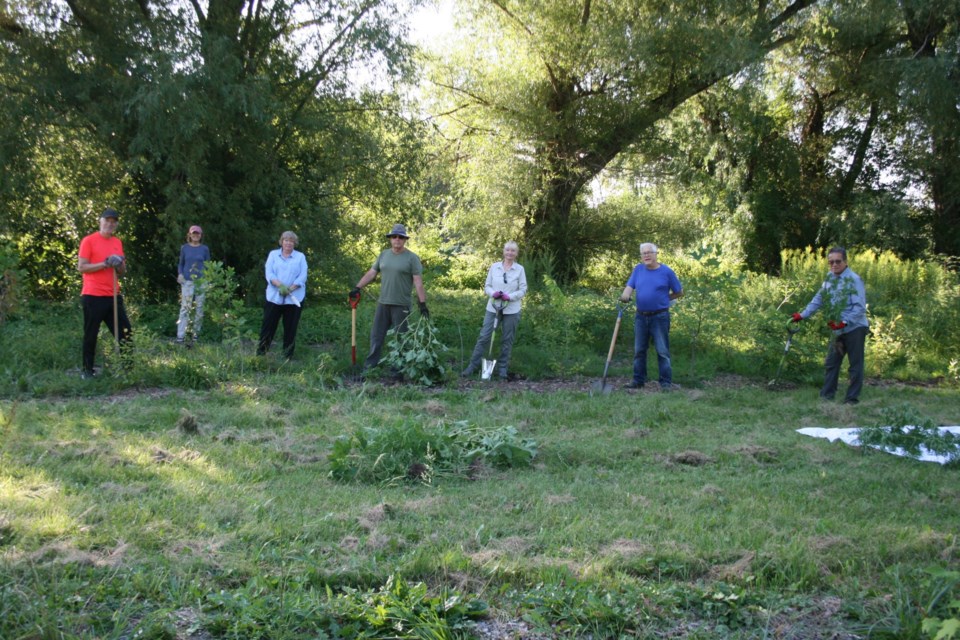Volunteers gathered at the corner of King and John Streets in the Old Town Saturday to perform some maintenance on an area planted last year by the Friends of One Mile Creek (FOMC).
Organized by chair Michael Fox, the event was the first chance since the riparian plantings occurred last Octo- ber that the Friends were able to get down to the nitty gritty of weeding.
“We had about 50 people out, in two groups of 25, last year to do the planting,” Fox says. “We planted several hun- dred native trees, 16 different species, and a lot of shrubs as well. We planted trees along the front to get some regeneration of the tree line, but this is more a mix of shrubs and trees.”
Fox explains the planting last fall was important for the parkland across from the Pillar and Post, where the creek flows on its way to Lake Ontario.
“Grass doesn’t provide any biodiversity, it doesn’t really absorb much water,” he says, “whereas the trees and shrubs will absorb water when there’s rainfall.”
“One Mile Creek can be dry at times, and can be overflowing at other times,” he continues. “It drains all of Old Town, and with all the building in Old Town there’s not as many places for the water to soak in. By planting along here, we’re providing much more capacity for the natural environment to absorb water.”
Realizing the town didn’t have the time or resources to plant new trees while concentrating resources on removing the dangerous, unhealthy ones, the Friends felt it was up to them to begin planting new trees to replace them.
Among the 450 plantings last year were three species of maple and four of oak, as well as tulip trees, willow, elderberry and chokeberry, all native to the Niagara area.
Fox said the Niagara Peninsula Conservation Authority (NPCA) was supportive in the efforts of FOMC last year.
“They organized getting the plant material and everything,” Fox says, “and they even helped organize getting some of the volunteers. They were very encouraging.”
There certainly was a much smaller group of volunteers involved in last Saturday’s mission to eradicate some of the unwanted growth.
“We have free membership, and an email list of over 100 members,” Fox claims. “This group was a little more active when it first got going, and did a lot of work. But it went into a little bit of dormancy. We’re starting to meet more often and be more active.”
In some locations Saturday it was hard to spot the trees and shrubs amongst the weeds that had overgrown them.
Klara Young-Chin, one of the original members of the Friends, pointed out that a special effort was being made to weed out the Manitoba maple and Norway maple trees, non-native species which proliferate at a great rate.
“Some of the weeding we’re doing is to just give the trees room to grow,” Fox explains. “Otherwise some of these invasives would just take over everything. We’d end up with a giant ragweed bed. We’re going to keep at this, especially along the front here.”
As the volunteers worked away, the weeds were placed in piles on the grass for their removal later by town staff.
One Mile Creek follows the natural contours of the land, weaving through Old Town neighbourhoods before pooling in Lansdowne Pond at its outlet to Lake Ontario. It’s a relatively small creek that drains a highly urbanized watershed area, and flows through mostly private property.
Owners of land abutting One Mile Creek and other interested individuals formed the Friends of One Mile Creek in 2003 because of concerns regarding the condition of the creek and associated Lansdowne Pond.
The goal of FOMC is to “collaborate with the community and relevant agencies to work efficiently toward restoring and revitalizing the water, wildlife and natural environment of the One Mile Creek watershed,” says its website.
Over the years, the group has been instrumental in plantng trees along the Heritage Trail, creating a pollinator garden in 2013 at William Street Park with more than 2,000 wildflower plugs, and creating another pollinator garden located at King and John Streets in 2017.
They have also run several Earth Day creek cleanups, and hosted a popular speaker series until 2012. In addition, working with the NPCA, the Friends created a comprehensive Stewardship Guide to educate and inform landowners along the creek, as well as other members of the community.
For information on membership, to sign up for their mailing list, or to download their Stewardship Guide, visit friendsofonemilecreek.org.
